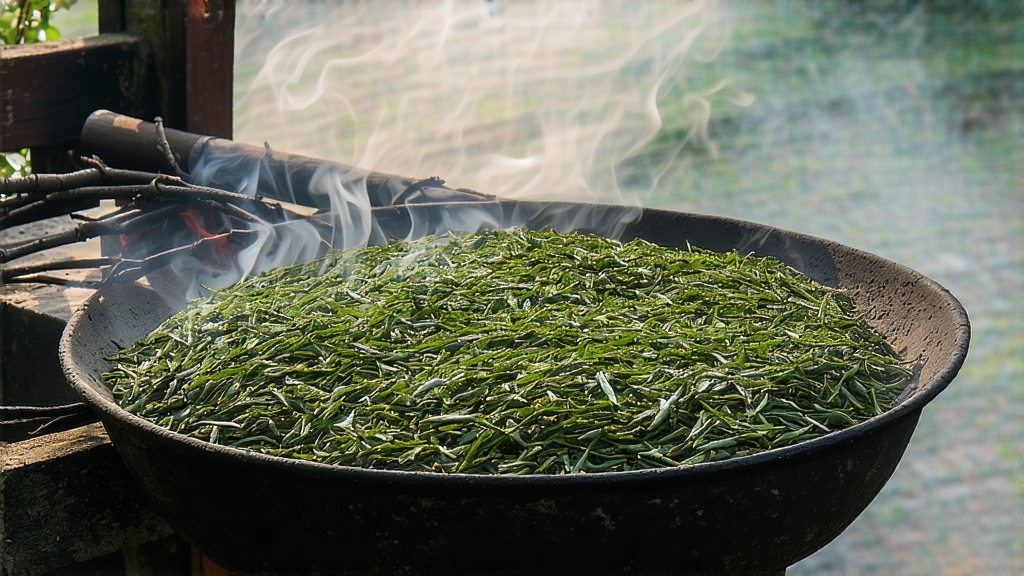
Long before Assam, Ceylon, or Earl Grey entered the global lexicon, the cliffs of northern Fujian echoed with the crackle of pine torches and the rustle of tea leaves. There, in the Wuyi Mountains, Lapsang Souchong—today celebrated as the world’s first black tea—was born out of accident, urgency, and the ingenuity of 17th-century tea masters. International drinkers often meet it as a curiosity, a smoky dram in a porcelain cup, yet its story is the prologue to every black tea now steeping on Earth.
Historical records kept by the Dutch East India Company show that “bohea” (the Min-dialect pronunciation of “Wuyi”) reached Amsterdam in 1604. The cargo was dark, tightly rolled leaves that yielded a ruddy liquor unlike the green teas Europe had known. Chinese annals are more poetic: pressed by marching Qing soldiers, villagers rushed the late-spring harvest through improvised withering over fresh pine embers. The smoke penetrated the leaf; the coppery color and malt-sweet depth surprised even its makers. Within decades caravans carried it across the Russian steppe, and clipper ships raced it around the Cape of Good Hope. A single chest of Lapsang once outbid a barrel of Madeira at London auction, cementing black tea’s status as a luxury commodity.
True Lapsang Souchong is not a generic smoked black; it is a protected geographical indication limited to the original Tongmu Guan micro-valley, a blind canyon where the Tongmu River cuts through weathered granite. Elevation (300–1,200 m), subtropical humidity, and mineral-rich mists create the “rock bone and floral heart” prized in Wuyi lore. Only the small-leaf cultivar xiao ye zhong (Camellia sinensis var. sinensis) is used; its low tannin and high sugar content provide the canvas for smoke without harshness. Two distinct styles now leave the valley: the traditional pine-smoked and the increasingly popular unsmoked “wild” version that showcases natural fruit and honey notes.
Craft begins before dawn when dew still pearls on the bud-and-two-leaf sets. Pickers climb terraced plots so narrow that footholds are carved into bedrock. The pluck is spread on bamboo trays inside wooden sheds where pine and cedar logs smolder below raised slats. Here, withering is half done by gentle heat and half by the valley’s natural draft, a process called “warm wind withering” that lasts six to eight hours. Once the leaves lose sixty percent of their moisture they are rolled—first mechanically kneaded to rupture cells, then hand-twisted on rattans to create the tight strip shape. Oxidation follows in humidified rooms kept at 24 °C; the leaf pile is turned every thirty minutes to ensure even browning. When the grassiness fully gives way to malt and dried-longan fragrance, firing occurs over the same pinewood embers. Masters control smoke density by adjusting the ratio of resinous heartwood to bark; too much resin masks sweetness, too little and the tea tastes hollow. A final charcoal bake at 80 °C fixes the aroma and reduces moisture below 5 %. From kilo to cup, forty hours of human attention have been lavished on every gram.
Brewing Lapsang Souchong is an act of translation: turning pine forests and mountain mist into a drinkable narrative. Use soft water, 90 °C, and a 1:50 leaf-to-water ratio in a pre-warmed gaiwan or small teapot. The first 5-second rinse awakens the leaf and washes away surface smoke; discard it without hesitation. Subsequent steeps lengthen by 5-second increments. A well-made traditional lot will deliver five clear chapters: campfire and dried longan on the nose; a bright copper liquor; a palate that moves from pine resin to cocoa, then to candied plum, and finally to a cooling camphor finish. Unsmoked versions trade smoke for orchid and honey, but both styles share a syrupy texture that lingers on the lips like peated single-malt.
Professional cupping follows the Chinese “three-breath” method. After slurping, hold the liquor against the hard palate and draw air in sharply through the front teeth; this volatilizes aromatics into the retronasal passage. On